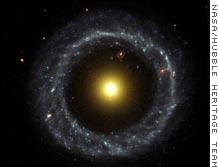 |
|
| This galactic pinwheel around a dense nucleus is known as Hoag's Object. | íí |
(Clearwisdom.net)
(CNN) --A band of bright blue stars encircles a central yellow core in one of the strangest galaxies observed by the Hubble Space Telescope.
The galaxy is about 120,000 light-years across, slightly larger than our own Milky Way. The ring is composed of hot young stars, while the interior is packed with much older, cooler ones.
The dark break between the bright circle and nucleus could actually contain clusters of stars too dim to detect, Hubble researchers said.
The image captures a face-on view of the galaxy, "revealing more detail than any existing photo of this object," they said in a statement this week.
"This image may help astronomers unravel clues on how such strange objects form."
Such star groups can evolve through numerous processes, according to astronomers. In some cases, one galaxy might pass through another, stoking an intense period of star births.
Yet this galactic oddity exhibits no sign of a collision with a second galaxy. Some scientists theorize that the blue star circle is the remnant of a galaxy that passed close by the central one, some 2 billion or 3 billion years ago.
In 1950, astronomer Art Hoag first detected the galaxy. Dubbed Hoag's Object, it is about 600 million light-years away in the constellation Serpens.
The image, which the Hubble's Wide Field and Planetary Camera captured in July 2001, was released by the Hubble Heritage Team, which is based at NASA's Space Telescope Science Institute in Baltimore, Maryland.
Source from: http://www.cnn.com/2002/TECH/space/09/06/hubble.pinwheel/index.html
Category: Falun Dafa in the Media





